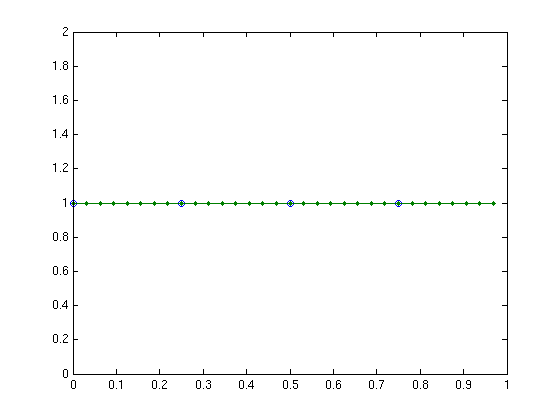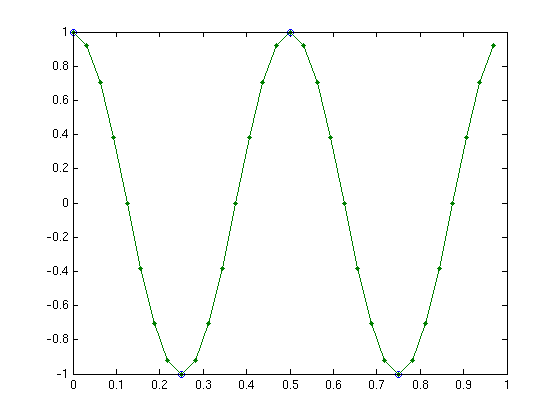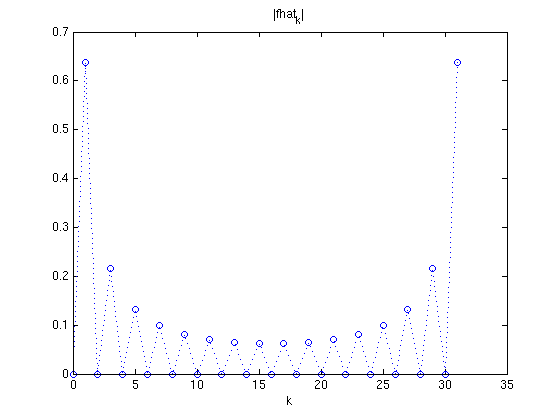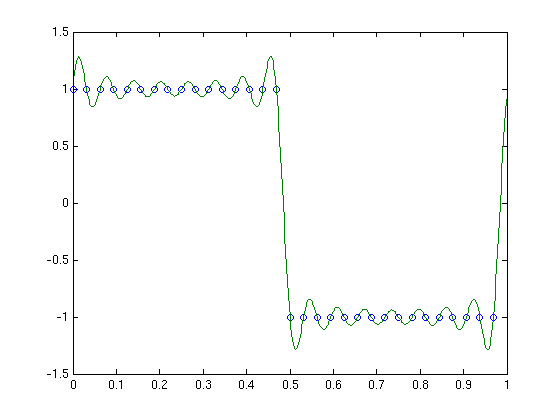Examples for discrete Fourier transform
Contents
You need to download some f-files
Download the following m-files and put them in the same directory with your other m-files:
format compact % don't print blank lines between results
Example 1
Here all data values are 1, so the interpolating function ftilde(x) should be the constant function 1, corresponding to fhat=[1,0,0,0].
f = [1,1,1,1] fhat = four(f)
f =
1 1 1 1
fhat =
1 0 0 0
Plotting the interpolating function
We find a Fourier vector ghat of length 32 which corresponds to the SAME function ftilde(x) by sticking zeros into the middle of the vector. Then the inverse Fourier transform of ghat gives the values in the time domain, but now on a finer grid.
N = 4; x = (0:N-1)/N; % grid points Np = 32; % use grid with Np=32 for plotting xp = (0:Np-1)/Np; % grid points ghat = fext(fhat,Np) % extend Fourier vector to length 32 by sticking 0's in middle g = ifour(ghat); % values of interpolating function on fine grid plot(x,f,'o',xp,g,'.-')
ghat =
Columns 1 through 13
1 0 0 0 0 0 0 0 0 0 0 0 0
Columns 14 through 26
0 0 0 0 0 0 0 0 0 0 0 0 0
Columns 27 through 32
0 0 0 0 0 0

Example 2
Here the interpolating function should be the function cos(4*pi*x), corresponding to fhat=[0,0,1,0].
f = [1,-1,1,-1] fhat = four(f)
f =
1 -1 1 -1
fhat =
0 0 1 0
Plotting the interpolating function
In order to obtain ghat which represents the SAME function ftilde(x) we need to split the coefficient 1 into 1/2 for frequency 2 and 1/2 for frequency -2:
ghat = fext(fhat,Np) % extend Fourier vector to length 32 by sticking 0's in middle g = ifour(ghat); % values of interpolating function on fine grid plot(x,f,'o',xp,g,'.-')
ghat =
Columns 1 through 7
0 0 0.5000 0 0 0 0
Columns 8 through 14
0 0 0 0 0 0 0
Columns 15 through 21
0 0 0 0 0 0 0
Columns 22 through 28
0 0 0 0 0 0 0
Columns 29 through 32
0 0 0.5000 0

Example 3
Here is a signal which is first 1 and then -1. Note that
- the Fourier coefficients for even frequencies are zero
- the Fourier coefficients for high frequencies (middle of the vector) get smaller
f = [ones(1,16),-ones(1,16)] fhat = four(f); N = length(f); x = (0:N-1)/N; plot(0:N-1,abs(fhat),'o:'); xlabel('k'); title('|fhat_k|')
f =
Columns 1 through 13
1 1 1 1 1 1 1 1 1 1 1 1 1
Columns 14 through 26
1 1 1 -1 -1 -1 -1 -1 -1 -1 -1 -1 -1
Columns 27 through 32
-1 -1 -1 -1 -1 -1

Plotting the interpolating function
Np = 512; xp = (0:Np-1)/Np; ghat = fext(fhat,Np); % extend Fourier vector to length 512 by sticking 0's in middle g = ifour(ghat); % values of interpolating function on fine grid plot(x,f,'o',xp,g)
